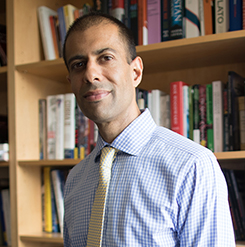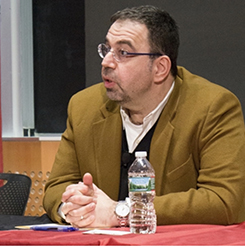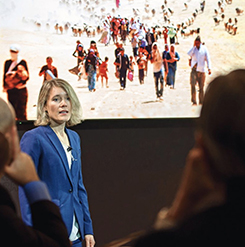Vipin Narang on the North Korea summits
Michelle English, Center for International Studies
First published here.
An historic April 27 summit between Moon Jae-in, president of South Korea, and Kim Jong-un, supreme leader of North Korea, has been lauded as a path to peace for the divided peninsula as well as a tipping point of the North Korean nuclear crisis. But what concrete actions should we expect from the meeting between Kim and Moon? And how will this affect the forthcoming summit between President Trump and Kim? MIT nuclear strategy expert Vipin Narang, an associate professor of political science and a member of its Security Studies Program, weighs-in with his observations, underscoring that rhetoric is key.

Vipin Narang, is associate professor of political science at MIT and a member its Security Studies Program. Photo: Jon Sachs/SHASS Communications
How does the recent Kim-Moon summit pave the way for the upcoming meeting between President Trump and Kim Jong-un?
VN: The Kim-Moon summit achieved its main objective: to set up the main event between President Trump and Kim Jong Un. As expected, it was long on optics and bonhomie, but short on specific details. The joint statement pledged aims and goals that mirrored previous North-South summits. The language on “denuclearization” was vague enough that President Moon could tell the US administration that the North reaffirmed the goal of “complete denuclearization,” while leaving enough ambiguity so that the North could claim that it reaffirmed goals such as the full denuclearization of the Korean Peninsula (which would have implications for the American extended nuclear deterrence commitment to South Korea) or as lofty as global nuclear disarmament.
What should we expect from US-North Korea summit?
VN: The devil will be in the details in the upcoming Trump-Kim summit and whether they can agree upon a common definition of “denuclearization” and steps that concretely achieve whatever that may be. Unfortunately, with the Trump Administration’s continued insistence on unilateral complete, verifiable, irreversible North Korean disarmament—and nothing short of that—something North Korea is exceedingly unlikely to agree to, the prospect of meaningful progress short of that (such as freezes on certain missiles and nuclear weapons) may be dwindling.
What advice do you have for President Trump?
VN: The most important thing is to keep expectations realistic. If President Trump believes that he is going to go to the summit to be handed the keys to Kim’s nuclear kingdom, he may be in for a rude awakening. There is no reason that the summit cannot achieve progress toward denuclearization and peace on the Korean Peninsula, but it will have to be steps and over a long period of time. Implementation and verification will be difficult, but not impossible. There is a deal to be had that benefits both sides, and the world. But it is unlikely to involve the unilateral surrendering of nuclear weapons by North Korea. So if the Trump administration is open to a deal short of that—which will still require some concessions from the United States—but which is a win-win, then the summit may yield fruit. But if not, a spectacular failure can be equally dangerous and pave the way to conflict. In my view, both the extreme success (unilateral North Korean disarmament) and the extreme failure (the meeting blowing up) are unlikely.
The most likely outcome is probably a nice photo-op and declaration which is long on rhetoric, pledging to work toward the denuclearization of the Korean Peninsula by some timeframe, but which commits neither side to anything immediately. This allows both sides to claim victory—Kim having met with the president of the United States as an equal and as a nuclear weapons power, and Trump extracting some vague commitment on denuclearization—and kick the can down the road.
Is democracy dying?
Peter Dizikes, MIT News Office
First published here.
Is democracy dying, in the US and around the world? Why or why not? And if so, what can anyone do about it?
Those vexing questions were at the heart of a public forum on the MIT campus Monday night, as scholars and journalists examined the current pressures on democratic systems of rule and suggested some measures to protect them. Held in the Stata Center, the event drew a standing-room only crowd of more than 300.

Daron Acemoglu, the Elizabeth and James Killian Professor of Economics at MIT, at the Starr Forum. Watch the Starr Forum here. Photo: Laura Kerwin/MIT Center for International Studies
“Is democracy dying? Well, I don’t know, but it’s certainly having a rough ride,” said Daron Acemoglu, the Elizabeth and James Killian Professor of Economics at MIT and co-author, with James Robinson, of the 2012 book, “Why Nations Fail.”
“We’re seeing attacks on the very norms and rules that we need for liberal democracy to be stable,” said Yascha Mounk, a lecturer on political theory at Harvard University and author of the new book, “The People Versus Democracy: Why Our Freedom Is in Danger and How to Save It.”
And as the panelists noted, the erosion of democracy is international trend, given a recent withering of rights and norms in Hungary, Kenya, Poland, Russia, Turkey, and Venezuela, among other countries — as well as contentious debate about governmental norms and the balance of powers in the US.
Journalist Maria Ramirez, who covers US politics for the Univision network, noted that there is now considerable public information about “a lot of details about the Russian operation to discredit democracy in the US,” underscoring that people need to understand the vulnerabilities such incursions exploit.
Acemoglu emphasized, in a central theme of his remarks, that democracy cannot be protected through anything other than ongoing citizen mobilization. Even the checks and balances of the US Constitution, he asserted, are not especially powerful. “They are not strong, and they weren’t designed to protect democracy,” Acemoglu said. “The only thing that can save democracy is society itself.”
Causes: Inequality, and much more
The Starr Forum is a long-running Institute event series sponsored by MIT’s Center for International Studies, which provides public discussions about international politics and global security issues.
Melissa Nobles, the Kenan Sahin Dean of MIT’s School of Humanities, Arts, and Social Sciences and a professor of political science, provided introductory remarks, noting that the status of democracy was “a question that is now probably occupying many of our fellow citizens in this country, and indeed around the world.”
Acemoglu suggested multiple factors have created stress on democracy, including a long-term shift toward income inequality, the exploitation of the media by authoritarian leaders around the globe, and a decline of manufacturing and trade unions — not strictly because of the ideological orientation of unions, but also because the capacity for civic engagement they once created is now dwindling.
So while economic inequality and the ensuing resentment against the political status quo is a factor, “It would also be a mistake to think it’s just about economic hardship,” said Acemoglu, who has written extensively on the relationship between political institutions and economic growth.
Conversely, Acemoglu added that despite the political stresses of the moment, “It’s not that easy to take down democracy,” because of the public awareness of rights and liberties that has accumulated over time.
Mounk pointed out that in concert with such trends, there has also been an alarming generational shift in tolerance for authoritarian rule and military rule; in surveys, about two-thirds of people born in the 1930s and 1940s said democracy was absolutely important, but less than one-third of those born in the 1980s and later agreed.
Mounk also noted that even recently political scientists regarded places like Hungary and Poland as democratic success stories, and thought the income levels and multiple transitions of power indicated such places had reached a state of stability. Instead, key rights have been eroded in those countries in recent years.
And while the U.S. has “an astounding record of political stability,” Mounk said, he expressed concerns about transitions of power at the state level, citing actions by the Republican-led state legislature in North Carolina, which moved to strip certain powers from the governor’s office after Democratic Party candidate Roy Cooper won it in November 2016.
For that matter, Mounk said, as much as democracy has built up a strong track record, we “don’t yet know what the dynamics of multiethnic democracy and the reaction against it are” in the long run, given the relatively short time periods in which such democracies have existed.
Maintaining democratic standards
In response to audience questions, the speakers suggested a few measures that could help the health of democracies around the globe.
“Support journalists is my message,” Ramirez said, calling good reporting “a public service that now is maybe more clear than ever.”
In response to one question, Acemoglu expressed some skepticism that technical tweaks to voting methods (such as preferential or instant-runoff voting) might ensure political stability, although he did assert that a reduction in gerrymandering, limits to the amount of money in US politics, and a smaller political influence in the U.S. civil service would be valuable changes.
Still, Acemoglu reiterated, “I think this is really about social mobilization.”
Mounk, who quipped that the panel consisted of “one semioptimist and two pessimists,” underlined that there are no certainties when it comes to the status of democracy, meaning that citizens who care about it should think about how best to engage with their governments.
“It makes you reflect a little bit about what you can actually do,” Mounk said. For US citizens, he told the audience, “You maintain agency” to take action where rights have already been stripped away from people in many other countries.
“So let’s use it,” Mounk concluded.
The final yard, with IPL's help
Mark Wolverton, 2016-17 MIT Knight Science Journalism Fellow
First published here.
Brilliant scientific ideas and ingenious technical solutions can’t really change the world if they never escape the laboratory and the pages of scientific journals. At a place such as MIT where innovation is an almost daily occurrence, that can be a frustrating dilemma. The International Policy Lab (IPL) was set up within MIT’s Center for International Studies (CIS) to help make the leap from the lab bench or seminar blackboard to the halls of Congress or a decision-maker’s desk.

Many MIT faculty members, such as Jessika Trancik (pictured above presenting her research on energy technologies in Davos, Switzerland), look to the MIT International Policy Lab for assistance in translating their findings into the language of policy. Photo: World Economic Forum, 2017
The genesis of IPL was the realization that we had a number of faculty members at MIT whose research was relevant for public policy”—with bearing on such important issues as energy, environmental science, national security, or health and medicine—“but who weren’t sure how to engage with the policy community,” says Chappell Lawson, associate professor of political science and IPL’s faculty director. As he puts it, “Sometimes we fumble the ball on the one-yard line, so that after a massive amount of work on the research side of things, for whatever reason that material doesn’t get into the right hands of the right people at the right time. That last piece is often what’s missing.”
Lawson joined MIT after a stint in government on the staff of the National Security Council in the Clinton Administration, and later took time out to serve in the Obama Administration working on border security issues for the Department of Homeland Security. It was upon returning from that second adventure in Washington that he, along with several other like-minded faculty, recognized that an opportunity to solve this problem was staring them in the face. “An assistant secretary in the federal government is not going to read a 30-page report, but they might take a meeting, listen to a short pitch, or read a one-page memo,” he says. What if MIT could help faculty members find the right way to engage with policy makers? About three years ago, Lawson and his colleagues secured funding from CIS, the dean of the School of Humanities, Arts, and Social Sciences, and the Office of the Provost, and began soliciting project proposals from the MIT community.
“An assistant secretary in the federal government is not going to read a 30-page report, but they might take a meeting, listen to a short pitch, or read a one-page memo,” Lawson says.
A good early example of the sort of projects that IPL has come to facilitate came from R. Scott Kemp, associate professor of nuclear science and engineering and director of the MIT Laboratory for Nuclear Security and Policy. Kemp’s project concerned the proliferation risks of a new laser enrichment process for uranium.
“The reason this was of interest was that there had been a quiet push to license and build a facility in the US, but no government agency had carried out a technical assessment of the nuclear weapons proliferation risk that the technology might bring if it were commercialized,” Kemp explains. According to Kemp, neither the Nuclear Regulatory Commission nor Congress chose to examine the problem, meaning “the US was moving forward in blind ignorance of potential risks to international security that this technology might involve. So we took it upon ourselves here at MIT to actually carry out that assessment.”
That’s where IPL came in. Says Kemp, “IPL not only supported our work and outreach, but also in essence carried out research relative to what the perceived risks were in government, so we understood what was already being taken into account, what was not being taken into account, and then who were the right people to talk to.” As it happened, the companies involved with the laser enrichment technology ultimately decided not to pursue it, but IPL was “instrumental in helping us get important technical facts into the hands of the people who needed to make decisions.”
Kemp’s next IPL project involved a new technical solution for the verification of nuclear warhead dismantlement. He says that IPL helped his group cut through the “not invented here” syndrome that often pervades federal bureaucracy and creates resistance to outsiders’ ideas. “We’ve certainly put them on notice that some of the technology development being done at MIT should be looked at more seriously, and IPL was very instrumental in making that happen,” Kemp says.
The IPL has helped MIT faculty reach international policy makers as well. Jessika Trancik, associate professor at the Institute for Data, Systems, and Society (IDSS), engaged IPL resources to respond to an Obama Administration request for a report on her research addressing the feedback between emission reduction policy and technological innovation in clean energy. That report was used by the White House to inform its work in the months leading up to the COP21 Paris Climate Conference in 2015, and referenced by State Department negotiators during the COP. Another of her IPL projects examined methane emissions, their effect on meeting US climate goals, and their relevance to energy policy. IPL has been “an invaluable resource for strategizing about how to translate research results into useful information for policy makers,” she says.
Trancik is also co-faculty director of the IPL with Lawson and Noelle Selin, an associate professor affiliated with IDSS and the Department of Earth, Atmospheric and Planetary Sciences. “So now I’m also working with IPL to think about how we can expand our footprint and build on this initial success and amplify that further,” Trancik says. “We’re brainstorming ways to get different projects and faculty members and researchers to engage with each other to share lessons and build a community around policy research here at MIT.”
What was originally conceived as a more or less one-way conduit from MIT to Washington is becoming more of a two-way connection, the beginnings of a symbiosis.
In addition to using IPL in their own work, faculty participants help to review the project proposals that IPL solicits annually from the MIT community. “The idea is to serve faculty at all five schools, including social scientists and urban planners and MIT Sloan faculty as well as scientists and engineers,” Lawson explains, noting different projects call for a range of approaches. “For some, the right strategy might be to meet with people in the executive branch. For others, it might be to meet with people on the Hill, or some combination of the two. And for still others, it might be a much larger audience, like experts who are outside of government or even the informed public who cares about the issue.”
Lawson boils down IPL’s services to three points: “The first is working with faculty members to define what it is that they want to get out of engaging with the policy community. The second is almost a matchmaking service, connecting faculty members with people in government, the executive branch, legislative staff, think tanks, the media, who are interested in the results of their research and are in a position to make policy that’s related to it. And we provide staff support and modest grants to faculty members for engaging in this sort of outreach.”



